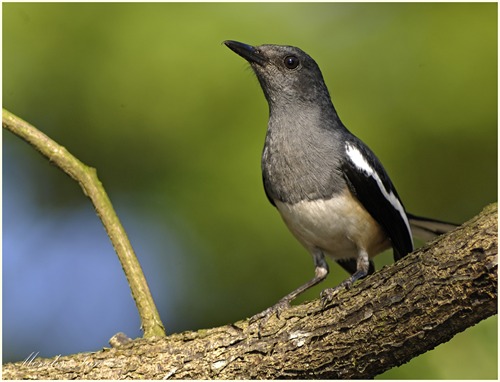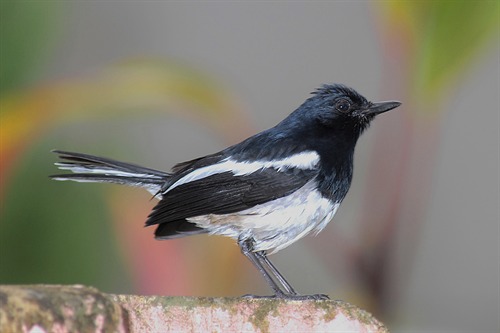
Back
Copsychus saularis (Linnaeus, 1758)
| Family Name: | |
| Taxonomic Group: | Vertebrates (Bird) |
| Common Name: | Oriental Magpie Robin |
Name
Description
| Description | With distinctive black and white plumage. Tail long. Males have glossy black with blue tinge head, breast and upperparts. Rest of underparts white. Tail black with white outer feathers. Wingbar bold white. Females have black upperparts but breast is dark grey. |
|---|
Ecology, Habitat & Location
| Ecological Notes | A bird of gardens, scrub, cultivation, forest edges and mangroves. The Magpie Robin was a common and familiar bird of the suburbs and countryside until the 1970s when the population from the main island vanished from many sites or became very scarce. The spectacular decline of the Magpie Robin was probably caused by a combination of poaching, habitat destruction (as large areas of agricultural land were developed) and perhaps most serious of all, competition from the increasingly numerous and more aggressive Javan and Common Mynas. |
|---|---|
| Habitats | Mangroves, Parks & Gardens, Forest, Terrestrial |
| Distribution | This species occurs from west Pakistan to south China and South-east Asia. In Singapore, the species was formerly very widespread, but is now reduced to the following sites: Bukit Batok, Serangoon, Punggol, Sembawang, Loyang, Poyan, Khatib Bongsu, Singapore Botanic Gardens, Sime Road, Changi, Sungei Buloh Wetland Reserve, Prince Albert Park, Fort Canning Park and Sembawang Park. It is also found on most offshore islands, with stable populations on Sentosa, Pulau Tekong Besar, Pulau Ubin, Pulau Hantu Besar and St. John's Island. |
| Nature Reserves | Central Catchment Nature Reserve, Sungei Buloh Wetland Reserve |
| Nature Areas | Pulau Tekong, Pulau Ubin, Pulau Hantu |
Conservation
| Trends & Threats | Poaching, habitat loss and competition with mynas. |
|---|---|
| Scientific Interest & Potential Value | The birds are very popular as aviary birds and well known for their singing ability. |
| Conservation Notes | Population estimated at between 50-150 birds. Less than 50 birds now survive on the main island and these appear to be stable. Many of the areas listed above have been protected as nature reserves or nature areas in the Singapore Green Plan 2012. Constant vigilance against poaching is needed to protect their vulnerable species. |
Status
| Species Status | Resident |
|---|---|
| Conservation Status | Uncommon |
| Singapore Red Data Book Status | Endangered (EN) [2008] |
Photos
References
| References | Davison, G.W.H., Ng, P.K.L. & Ho, H.C (Eds.). 2008. The Singapore Red Data Book (2nd Edition). Singapore: Nature Society (Singapore). 285pp Lim, K.S. & Gardner, D. 1997. Birds: An illustrated field guide to the birds of Singapore. Singapore: Sun Tree Publishing Limited. 226pp Wang, L.K. & Hails, C.J. 2007. An annotated checklist of the birds of Singapore. Raffles Bulletin of Zoology Supplement no. 15. 179pp |
|---|


.jpg)
